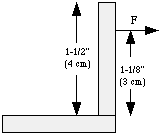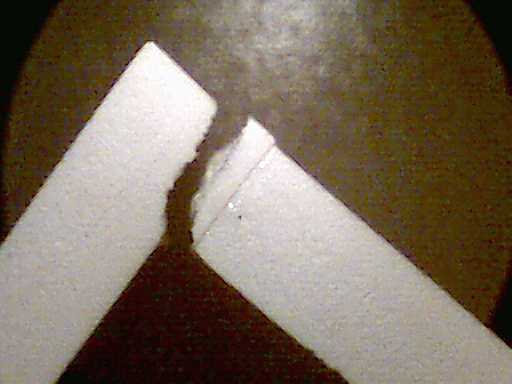|
|
In order to objectively compare the
performance of different adhesives, I
decided to perform side-by-side torture
tests. I cut out some strips 2 cm (3/4")
wide from 6mm (1/4")
Sintra®, glued
up test samples, and pull-tested them to
failure.
This quick diagram shows the basic
geometry I used (the horizontal piece in
the diagram is fastened firmly to a table
during testing).
|
|

|
Note that in my setup I'm adhering the face sheet
of one piece to an edge (largely "core" material)
of another piece. I did this for a number of
reasons:
- It gives me an easy test setup (requiring
less force than for an in-line pull).
- It provides some insight into the fracture
mechanics of the material.
- It makes for a more challenging adhesive
test, as some adhesives adhere well to just the
core material, or just the face sheets.
- Most of your Sintra® joints are likely
to be edge-to-face joints in 'bot
construction.
Note that I cut my test pieces on a table saw;
since this yields very smooth and square edges, my
results may differ from yours (but more on this
later).
I have performed this testing with eight
different adhesives so far: two
cyanoacrylates1 ("super glue"), a
quick-setting epoxy, a high-strength (slow-setting)
epoxy, another epoxy made just for work with
plastics, a vinyl toy patching adhesive, and two
different PVC cements. Note that before gluing up
Sintra®, it must be dry, clean, and degreased.
For me, this meant I sanded the areas to be joined
with 220 grit sandpaper, and wiped them with IPA
(isopropyl, a.k.a., rubbing alcohol). Now on to the
results...
- 6 minute epoxy -- a bit of a disappointment,
the joint suffers an adhesive failure with 600 g
(21 oz) load. The failure leaves a clean break
at the face sheet side of the joint (i.e.,
between the epoxy and the side of the vertical
member in the image above). I've heard a number
of good reviews of using Epoxy with Sintra®.
I have to assume that there may be a strong
dependence on glue brand and type, as I've had
consistently, repeatably, bad results with
it.
- PVC pipe cement (Oatey clear)-- here the
joint fails just inside the core at 1200 g load
(42 oz). A thin layer bit of core is pulled
loose and left adhered to the face sheet side of
the joint. While probably good enough for a
small BEAMbot,
this result was also a bit disappointing, since
I was expecting PVC pipe cement to do very well
with PVC sheet.
- High-strength epoxy -- about 4 times
stronger than the fast-setting stuff, this takes
24 hours to cure but failed at 2.3 kg (5lb)
load. The joint failure was entirely within the
dried epoxy.
- Vinyl adhesive ("One-drop Vinyl Glue") --
made for patching vinyl toys, it was a so-so
performer on Sintra. A bit of solvent welding
took place, with the joint failing just inside
the core at 2.3 kg (5 lb) load.
- Devcon "Plastic
WelderTM" -- a
2-part adhesive, looks like epoxy, mixes like
epoxy, sold next to epoxies, but maybe not an
epoxy per se. If nothing else, this
should win an award for the smelliest glue
around (use this stuff only with serious
ventilation). This also did a bit of solvent
welding, with the joint failing just inside the
core at 5 kg (11 lb) load.
- Gel cyanoacrylate1 ("super glue,"
"krazy glue") -- a fairly good performer, the
joint failed primarily in the dried adhesive,
but tore some core material out as well, at 5.5
kg (12 lb) load.
- Thin cyanoacrylate1 ("super
glue," "krazy glue") -- the champion to date,
and a real surprise to me in that the joint is
consistently stronger than the surrounding
material. When tested to failure, material near
the joint fails at approx. 12,000 g (yep, 12 kg
-- 25 pounds).
Here's an enlarged view of a cyanoacrylate joint
break (click on the image to show it at
10x):

Note that the break starts right at the
edge of the joint (this is the site of maximum
stress in my test setup), and propagates through
core material roughly parallel to the joint.
It's not very visible in this image, but the
break precisely follows the edge of some
adhesive "slop" on the edge of the material
closest to the camera. All this confirms what I
was expecting from the material -- the majority
of its strength comes from the face sheets; the
core has very little tensile strength on its
own.
Some hobby web sites swear by Oatey's "PVC to
ABS Transition Cement;" I'll rerun this test with
some if I can ever find it. Meanwhile, there are
some bad boys to talk about...
Adhesive hall of shame
I tried a number of adhesives that didn't work
at all -- so poorly, in fact, that the joint could
be broken with gentle fingertip pressure.
- Glue for plastic (styrene) models -- no real
surprise here, since PVC is nothing at all like
styrene chemically.
- Oatey's "X-15" glue for PVC sheet -- this
glue's poor performance really surprised me,
since the test involves working with PVC sheet,
after all. This joint was incredibly flexible,
and gave little resistance to any applied force.
I think used chewing gum would have done better
than this stuff.
Adhesive conclusions
One thing to bear in mind (and this only occurred
to me as I wrapped up this documentation) is that
all my test samples were cut on a table saw. This
yielded edges that were very square and flat; not
at all what you'll see if you cut your sintra with
a knife and smooth the edges with a file and
sandpaper. In particular, thin cyanoacrylate is not
really suited to joints which require some degree
of gap filling. This being the case, my personal
recommendations on adhesives to use with
Sintra® are as follows:
Your first choice should be some sort
of cyanoacrylate -- thick or thin, depending on
the situation. Thick is a bit easier to handle
(so it doesn't run all over the place), and is
best for joints where there are small gaps to be
filled. Thin is a bit trickier to handle, but
gives the very best strength, presuming no gap
filling must be done.
If you choose not to use a cyanoacrylate, a
good high-strength epoxy is likely your best
alternative. It's easy to find, and reasonably
strong. Note that higher strength epoxies
require longer curing times, so be prepared to
be patient if you go this route. Also note that
you have to mix up epoxy as you use it, so
you'll need to plan ahead a bit to avoid either
running out or wasting large amounts of your
epoxy.
Fasteners
While you can see you've got good adhesive
choices, sometimes you just need to put things
together in a reversible way -- here, you'll need
to use fasteners, which are the subject of the
next
page.
Notes:
1. Confusing the issue here is
the fact that "Super Glue" is both the name of a
company, as well as the brand name of their
particular blends of cyanoacrylate adhesives. In
fact, the Super Glue Corp. made the two
cyanoacrylates I tested, as well as both the
high-strength and 6 minute epoxies. Meanwhile,
"super glue" has become sort of a generic slang for
cyanoacrylate glues in general (likely due to the
fact that "Super
GlueTM"
was one of the first such adhesives to market). For
the sake of clarity, I use the terms
"cyanoacrylate" or "CA" to denote such adhesives
for the purposes of this writeup.
|

